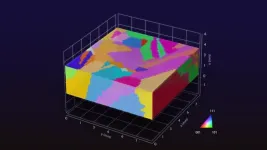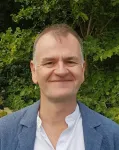(Press-News.org) If we don’t take out the trash regularly, our homes become unpleasant and even a danger to our health. The same applies to our cells: If excess proteins and strands of genetic material aren’t removed, the cell and ultimately the entire organism can fall ill. For instance, scientists suspect there is a connection between Alzheimer’s and mutations that cause defects in cellular garbage removal. What’s more, tests with mice have shown that suppressing the breakdown of DNA and RNA can trigger serious autoimmune diseases.
But concrete evidence is missing: “There’s a lot of research showing how genetic information in the form of DNA and RNA is produced in humans. But there’s less knowledge about how waste DNA and RNA are removed,” says Professor Oliver Daumke, a lab leader at the Max Delbrück Center. To address this, he teamed up with researchers from Kiel University to examine waste removal in cells in more detail. Their work focused on an enzyme called PLD3, which is responsible for breaking down waste. The researchers began by determining its structure using a crystal structure analysis. They were able to identify specific segments that play a key role in breaking down RNA and DNA. “That gave us a better understanding of how the waste is broken down and of the morbid effects of mutations in the PLD3 protein,” says Daumke.
Mutations in the PLD3 gene raise Alzheimer’s risk
PLD3 belongs to a protein family of enzymes that normally break down cellular fats in human cell organelles known as lysosomes. In humans, PLD3 is produced by a gene of the same name. “We’ve been looking at the PLD3 gene for some time already, because it became clear a few years ago that mutations in the gene could be involved in the development of Alzheimer’s,” says Professor Markus Damme of Kiel University. “Our work, as well as work by other researchers, showed that PLD3 actually breaks down DNA and RNA instead of fats,” he says.
“But it wasn’t clear how this was happening,” says Cedric Cappel, a researcher in Damme’s group and co-lead author of the paper. “So we decided to examine the protein’s structure more closely – in the hope that we could learn something about its link to Alzheimer’s.” Cappel made some of the protein and sent it to Dr. Yvette Roske, a structural biologist in Daumke’s lab and the other co-lead author of the paper. She succeeded in producing tiny crystals of PLD3. Exposing the crystals to X-rays produces a diffraction pattern that made it possible to reconstruct the protein’s structure. Roske could then depict the crystal structure with and without a bound RNA, and analyze it. “We found that two of these proteins combine to form something called a dimer. We haven’t seen that happen among other enzymes in this family,” says Roske. But why do the proteins do this? “It could be because the protein is only stable in a pair,” says Cappel. “Alone, it would probably be broken down.”
Through their work, these two research groups have provided the first structural proof of DNA and RNA being broken down by PLD3. “Now we can gain a rough understanding of the reaction mechanism,” says Roske. The researchers also found two areas of the protein that could be key to its functioning and presumably altered in Alzheimer’s patients – an early indication of a possible disease mechanism.
“Our research has provided a map of the protein,” says Cappel. Future studies of PLD3 can use this map to answer questions such as which areas are key to the functioning of PLD3, and what happens when changes are made to these areas. The researchers hope this will lead to a better understanding of the role the protein plays in certain diseases. This knowledge would then potentially make it possible to take corrective action.
Further information
Daumke lab
AG Damme at Kiel University
Literature
Yvette Roske, et al. (2023): “Structural analysis of PLD3 reveals insights into the mechanism of lysosomal 5’-exonuclease-mediated nucleic acid degradation”, in Nucleic Acids Research, DOI: 10.1093/nar/gkad1114
Contacts
Christina Anders
Editor, Communications Department
Max Delbrück Center
+49-(0)30-9406-2118
christina.anders@mdc-berlin.de or presse@mdc-berlin.de
Max Delbrück Center
The Max Delbrück Center for Molecular Medicine in the Helmholtz Association (Max Delbrück Center) is one of the world’s leading biomedical research institutions. Max Delbrück, a Berlin native, was a Nobel laureate and one of the founders of molecular biology. At the locations in Berlin-Buch and Mitte, researchers from some 70 countries study human biology – investigating the foundations of life from its most elementary building blocks to systems-wide mechanisms. By understanding what regulates or disrupts the dynamic equilibrium of a cell, an organ, or the entire body, we can prevent diseases, diagnose them earlier, and stop their progression with tailored therapies. Patients should be able to benefit as soon as possible from basic research discoveries. This is why the Max Delbrück Center supports spin-off creation and participates in collaborative networks. It works in close partnership with Charité – Universitätsmedizin Berlin in the jointly-run Experimental and Clinical Research Center (ECRC), the Berlin Institute of Health (BIH) at Charité, and the German Center for Cardiovascular Research (DZHK). Founded in 1992, the Max Delbrück Center today employs 1,800 people and is 90 percent funded by the German federal government and 10 percent by the State of Berlin.
END
Taking out the cellular trash
2023-12-20
ELSE PRESS RELEASES FROM THIS DATE:
Aerogel can become the key to future terahertz technologies
2023-12-20
High-frequency terahertz waves have great potential for a number of applications including next-generation medical imaging and communication. Researchers at Linköping University, Sweden, have shown, in a study published in the journal Advanced Science, that the transmission of terahertz light through an aerogel made of cellulose and a conducting polymer can be tuned. This is an important step to unlock more applications for terahertz waves.
The terahertz range covers wavelengths that lie between microwaves and infrared light on the electromagnetic spectrum. It has a very high frequency. Thanks to this, many researchers ...
Slimming significantly alters your microbiome and brain activity
2023-12-20
Worldwide, more than one billion people are obese. Obesity is a risk factor for cardiovascular disease, diabetes, and some cancers. But permanently losing weight isn’t easy: complex interactions between body systems such as gut physiology, hormones, and the brain are known to work against it. One method for weight loss is intermittent energy restriction (IER), where days of relative fasting alternate with days of eating normally.
“Here we show that an IER diet changes the human brain-gut-microbiome axis. The ...
Giving video games this Christmas? New research underlines need to be aware of loot box risks
2023-12-20
Recent controversy has surrounded the concept of loot boxes – the purchasable video game features that offer randomised rewards but are not governed by gambling laws.
Now research led by the University of Plymouth has shown that at-risk individuals, such as those with known gaming and gambling problems, are more likely to engage with loot boxes than those without.
The study is one of the largest, most complex and robustly designed surveys yet conducted on loot boxes, and has prompted experts to reiterate the call for stricter enforcement around them. ...
Large language models validate misinformation, research finds
2023-12-20
New research into large language models shows that they repeat conspiracy theories, harmful stereotypes, and other forms of misinformation.
In a recent study, researchers at the University of Waterloo systematically tested an early version of ChatGPT’s understanding of statements in six categories: facts, conspiracies, controversies, misconceptions, stereotypes, and fiction. This was part of Waterloo researchers’ efforts to investigate human-technology interactions and explore how to mitigate risks.
They discovered that GPT-3 frequently made mistakes, contradicted ...
Artificial intelligence unravels mysteries of polycrystalline materials
2023-12-20
Researchers at Nagoya University in Japan have used artificial intelligence to discover a new method for understanding small defects called dislocations in polycrystalline materials, materials widely used in information equipment, solar cells, and electronic devices, that can reduce the efficiency of such devices. The findings were published in the journal Advanced Materials.
Almost every device that we use in our modern lives has a polycrystal component. From your smartphone to your computer to the metals and ceramics in your car. Despite this, polycrystalline materials are tough to utilize because of their complex structures. Along with their composition, the performance ...
Asian Fund for Cancer Research Limited unveils inspiring new logo and slogan, signifying a global commitment to advancing cancer research - from Asia to the world.
2023-12-20
The Asian Fund for Cancer Research (AFCR) is thrilled to unveil its fresh brand logo and slogan, marking a pivotal moment in the organization's quest to advance breakthroughs in cancer globally. The redesigned emblem and impactful slogan firmly establish AFCR as a prominent voice in the ongoing battle against cancer, extending its influence beyond Asia.
"Advancing Cancer Breakthroughs from Asia to the World"
This compelling slogan powerfully encapsulates AFCR's unwavering commitment to drive innovation and foster collaboration in cancer research ...
Beetroot juice supplement lowers blood pressure and improves exercise capacity in people with chronic obstructive pulmonary disease
2023-12-20
A 12-week course of daily beetroot juice supplement for people with chronic obstructive pulmonary disease (COPD) lowered blood pressure and improved how far patients could walk in six minutes in research published today (Wednesday) in the European Respiratory Journal [1].
COPD is a serious lung condition affecting around 400 million people worldwide [2]. COPD which includes chronic bronchitis and emphysema, causes breathing difficulties and severely limits people’s capacity for physical activity. It also increases the risk ...
Finding that statins could slow dementia stimulates further research
2023-12-20
Blood fat-lowering statins could slow the progression of Alzheimer's disease, at least for some patients. This is the result of a new study led by Karolinska Institutet published in Alzheimer Research and Therapy. But the researchers are cautious in their interpretations and see the results as a first step in a research journey that may eventually provide the answer.
A new study shows that people with Alzheimer's dementia deteriorated more slowly in their cognitive functions if they were also treated with a lipid-lowering ...
Potentially harmful ‘trip-killers’ to cut short ‘bad’ drug trips, emerging concern, warn doctors
2023-12-20
The use of potentially harmful ‘trip-killers’ to cut short ‘bad drug trips’ after taking psychedelics, such as LSD or magic mushrooms, is an emerging concern, warn doctors in a research letter, published online in Emergency Medicine Journal.
Their analysis of relevant threads on the social media platform Reddit, shows that drugs such as benzodiazepines (sedatives) and antipsychotics are the options most frequently recommended, but warnings about their potential side effects are rarely included, they highlight.
The intensity of a psychedelic drug trip can cause distress, agitation, ...
3 potentially unique acoustic features of healing music that transcend genre identified
2023-12-20
There are three potentially unique acoustic features of healing music that transcend musical genres, suggests research published in the open access journal General Psychiatry.
The findings might help to personalise playlists for patients, using artificial intelligence to analyse individual physiological and psychological responses, and help to evaluate the effectiveness of existing music therapies, suggest the researchers.
Despite evidence of the therapeutic effects of music for mental health issues, such as anxiety, depression, and post traumatic stress disorder, there’s no consensus on what defines healing ...




